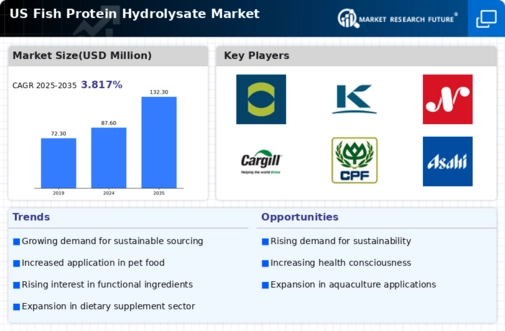Rising Popularity of Pet Nutrition
The increasing focus on pet health and nutrition is emerging as a notable driver for the fish protein-hydrolysate market. Pet owners are becoming more discerning about the ingredients in their pets' diets, leading to a surge in demand for high-quality protein sources. Fish protein hydrolysates are being recognized for their digestibility and palatability, making them an attractive option for pet food manufacturers. The pet food market in the US is projected to exceed $100 billion by 2027, with premium and functional pet foods gaining popularity. This trend suggests a growing opportunity for the fish protein-hydrolysate market to cater to the evolving preferences of pet owners, potentially leading to increased product development and innovation in this space.
Expansion of Sports Nutrition Sector
The burgeoning sports nutrition sector is significantly influencing the fish protein-hydrolysate market. With an increasing number of athletes and fitness enthusiasts seeking effective recovery solutions, the demand for protein supplements is surging. Fish protein hydrolysates, known for their rapid absorption and high bioavailability, are becoming a preferred choice among this demographic. Market analysis indicates that the sports nutrition market in the US is expected to reach $45 billion by 2026, with protein supplements accounting for a substantial share. This growth presents a lucrative opportunity for the fish protein-hydrolysate market, as manufacturers innovate to create specialized formulations targeting athletes' needs. The alignment of fish protein hydrolysates with the performance enhancement goals of consumers could drive substantial growth in this segment.
Health Consciousness Among Consumers
The increasing awareness of health and wellness among consumers is a pivotal driver for the fish protein-hydrolysate market. As individuals seek to enhance their diets with high-quality protein sources, fish protein hydrolysates are gaining traction due to their rich amino acid profiles and digestibility. This trend is particularly pronounced in the US, where the demand for functional foods is on the rise. According to recent data, the health and wellness food sector is projected to grow at a CAGR of approximately 8% over the next five years. This growth is likely to bolster the fish protein-hydrolysate market, as consumers gravitate towards products that offer nutritional benefits without compromising on taste or quality. The fish protein-hydrolysate market is thus positioned to benefit from this health-centric consumer behavior.
Innovations in Food Processing Techniques
Advancements in food processing technologies are playing a crucial role in shaping the fish protein-hydrolysate market. Innovative extraction and hydrolysis methods are enhancing the efficiency and quality of fish protein hydrolysates, making them more appealing to manufacturers and consumers alike. Techniques such as enzymatic hydrolysis are being refined to produce hydrolysates with specific functional properties, which can be tailored for various applications, including food and beverages. The fish protein-hydrolysate market stands to benefit from these technological advancements, as they enable the production of higher-quality products that meet the growing consumer demand for functional and health-oriented food options. This evolution in processing could lead to a more competitive landscape within the market.
Increased Regulatory Support for Seafood Products
The regulatory environment surrounding seafood products is becoming increasingly supportive, which may positively impact the fish protein-hydrolysate market. Government initiatives aimed at promoting sustainable fishing practices and ensuring food safety are likely to enhance consumer confidence in seafood-derived products. The US government has implemented various programs to support the seafood industry, including funding for research and development. This regulatory backing could facilitate the growth of the fish protein-hydrolysate market by encouraging innovation and ensuring compliance with safety standards. As consumers become more aware of the importance of sourcing and safety, the demand for fish protein hydrolysates may rise, driven by the assurance of quality and sustainability.

















Leave a Comment